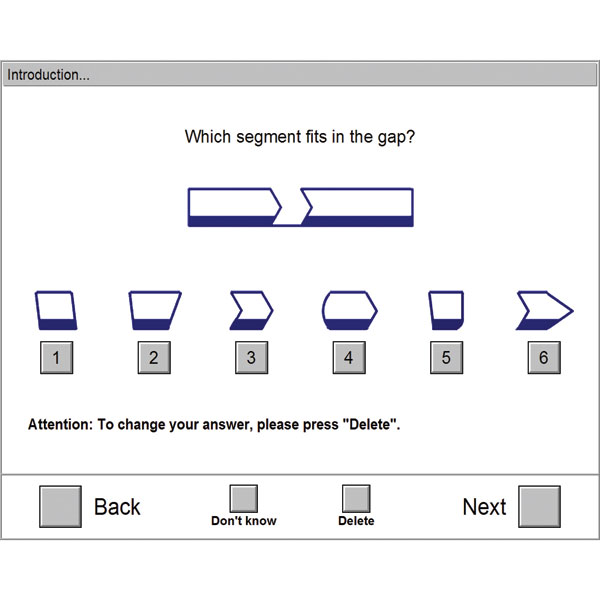
Visualization - 2D - 1 Year License
Model 64100
Non-verbal test which assesses mental imagination and transformation of spatial arrangements in two-dimensional space; applicable at the age of 15 years and over.
Test Overview
Visualization, as it is assessed in this test, is an aspect of intellectual capacity providing the psychologist with essential information about the respondent which cannot be assessed with other cognitive tests. It is the ability to think in various dimensions and to organize thoughts on the basis of mental pictures.
Main Areas of Application
- Performance-related aptitude diagnostics
- Clinical psychology
- Neuropsychology
- Traffic psychology
- Aviation psychology
- Industrial and organizational psychology
- Decisions in school, studies and career
Theoretical Background
The primary object of measurement is the factor Spatial Ability (S) in the sense of Thurstone's theory of primary mental abilities (Thurstone, 1938). This factor was not only multiply confirmed by the factor analytics (e.g. Guilford, 1956) but also by the adherents of the hierarchical intelligence models (e.g. Spearman, 1927; Burt, 1949; Ver- non, 1950). Recent research on intelligence describes the factor as one of the "Multiple intelligences" (e.g. Gardner, 2001). Finally, Sternberg's "Three factor theory" (Sternberg, 2000) includes abilities which by definition correspond to the S-factor.
Administration
A given figure has to be completed. The starting point is a bar which has differently shaped breaches for each task. Beneath 16 segments are shown which also are differently shaped. The task for each item is to pick one, two or three segments out of the 16 that will complete the bar. The test has 22 items. For the first 8 items only one segment is needed to complete the bar, for the next 8 two segments are needed, and for the last 6 three parts are needed.
Test Forms
There is one test form.
Scoring
The number of correctly solved items constitutes the score for visualization / spatial ability. The printout shows raw- and standard- values for the total performance.
Reliability
The split-half reliability coefficients vary between r =0.84 and 0.86 for respondents with different educational levels.
Validity
The face validity is evident - the respondents think immediately of "perception of forms" and "laying a jigsaw puzzle". The logical validity is given by the operational definition of the measurement content. Content validity has been proven through analyses of correlations. The content of 2D is similar to the content of other spatial ability tests, which have good predictive validity for a variety of occupations. Thus, predictive validity can be ascribed to the 2D as well.
Norms
Standardization was performed on a representative sample of normal persons (N=255) which was collected at the Schuhfried Company's research lab in 2004. These norms are available separately by gender, age and educational level.
Norms for a sample of 547 Swedish working adults are available as well. Subdivisions according to educational level and age are included.
Testing Time
The testing time is 6 minutes. Add approximately three minutes for instructions and solving the practice items.
VTS System Overview
The Schuhfried VTS enables computer-assisted application of a large number of highly diverse psycho-diagnostic tests and measuring procedures. In developing the system much emphasis was placed on transparent structure and largely uniform design. It is therefore simple to operate and easy to understand and does not require any special computer skills.
The VTS basic module is required for administration of any of the available tests.
The Schuhfried VTS supports the administration of both single tests and test batteries. Many of the single tests are available in different test versions. These test versions may differ, for example, in terms of test duration or difficulty or may be parallel forms. They are characterized by different parameters reflecting specific test requirements. They have been designed for administration to a specific population (e.g. psychiatric patients, children, etc.) or for special measuring purposes (e.g. repeated measurements). Test batteries are compiled from the available single tests and test versions.
